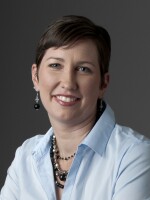Cooks use math to make beautiful food all the time: Slicing eight perfect pieces of pie or doubling a recipe requires basic knowledge of fractions, for example.
But how many cooks think about using beautiful food to illustrate the math itself?
Lenore M. Edman and Windell H. Oskay of the blog Evil Mad Scientist Laboratories do. Feast your eyes on their latest work, "Sconic Sections," pictured above.
Now, you may remember from high school Algebra II class (or, like me, you looked it up) that, when a plane slices through a cone, four kinds of geometric curves can occur: an ellipse, a circle, a hyperbola or a parabola. These curves are called conic sections.
And, of course, a scone is something you grab at Starbucks on your way to the office or, if you're all proper and English, you eat it with a spot of tea and clotted cream.

"And, at the intersection of the two, we present something entirely new, delightfully educational, and remarkably tasty: Sconic Sections," Edman writes in her blog post, a meticulously detailed, step-by-step manual for making your own jam-and-Nutella topped math treats.
The pair recently spoke with The Salt about the project. Below is our chat, edited for length and clarity.
In plain English, what is Evil Mad Scientist Laboratories?
Edman: "Evil Mad Scientist Laboratories is a blog we started to keep track of our hobbies, originally. It's grown into much more than that. We sell hobby electronic kits, and we still publish when we can."
Why use food to illustrate a complex math subject like conic sections?
Edman: "One of the things about doing math in food is that it makes it more concrete and understandable — hopefully, your scones aren't concrete — but it's much more tactile. [In class,] they're usually just diagrams, but the slices [in our scones] really stand out to you when you use Nutella."
Why do we need to know what conic sections are, anyway?
Edman: "Let's use the example of a lamp fixture: Light comes out of the lampshade as a cone of light — things come out as a circle or an ellipse. If you're close enough to the wall, you'll see a hyperbola ..."
So it comes in handy in that you can use it to figure out where the light is thrown when you're decorating?
Oskay: "It's useful if you want to understand why it forms the shape it does."
Edman: "It's just a nice way to augment traditional learning — just as a way to enjoy the math at another level. We see math in everything we do. We're the kind of people who play board games at the dinner table."
How did you decide on scones as your medium?
Both: "The pun!"
I notice both of you mention your affection for food in your bios, and these aren't the first food items you've experimented with. Is there a larger connection between food and science you're trying to illustrate, or is it all just for fun?
Edman: "It's another way of experiencing science. Not only do you get to experience the math concept, but you get the chemistry of doing the cooking."
Oskay: "It's a chance for people to learn before they have the chance to think [math is] scary."
Want more food-illustrated math? Check out these Sierpinski cookies and Koch snowflake cupcakes.
Copyright 2020 NPR. To see more, visit https://www.npr.org. 9(MDAwMzY5MzE4MDEzMTE3ODg5NDA4ZjRiNg004))



